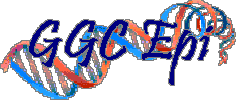Part 2: Linkage Analysis
That's right. Now here is the table of values that you generated.
| FAMILY | ID# | FATHER | MOTHER | SEX | STATUS |
| 4329 | 1 | 0 | 0 | 1 | 1 |
| 4329 | 2 | 0 | 0 | 2 | 2 |
| 4329 | 3 | 1 | 2 | 1 | 2 |
| 4329 | 4 | 0 | 0 | 2 | 1 |
| 4329 | 5 | 1 | 2 | 2 | 2 |
| 4329 | 6 | 1 | 2 | 1 | 1 |
| 4329 | 7 | 1 | 2 | 2 | 2 |
| 4329 | 8 | 1 | 2 | 1 | 1 |
| 4329 | 9 | 1 | 2 | 1 | 1 |
| 4329 | 10 | 1 | 2 | 2 | 2 |
| 4329 | 11 | 3 | 4 | 2 | 2 |
| 4329 | 12 | 3 | 4 | 2 | 2 |
This table provides information about the pedigree, but we must also supply the computer with genetic marker information in order to find a region where the defective gene may be located.
What is a genetic marker? There are several types of genetic
markers, and
they all have two characteristics in common. First, they are polymorphic.
This means that different normal individuals can have different versions of
the sequence in that spot. In fact, one individual can have a different
version of the sequence on each of the two chromosomes in that respective
pair. This enables one to tell which of the two chromosomes from that pair
the parent has passed to the child. The second characteristic all markers
have is that we know where that stretch of sequence lies on its chromosome. This
enables us to line the markers up in their spatial order on the chromosome, and
see where recombinations have occurred during meiosis. A recombination will be
indicated when a child inherits a chromosome that contains markers from both of
the respective chromosomes possessed by the parent. For example, a boy may have
a chromosome 1 in which the markers from the p telomere to p31 have come from
one of his mother's chromosome 1's, but the markers from p31 to the q telomere
have come from his mother's other chromosome 1. In this case, a recombination
has occurred in p31.
One type of marker is a microsatellite marker, in which 2, 3 or 4
nucleotides are repeated in a string (example, CACACACACA, CAGCAGCAGCAG or
GATAGATAGATAGATA). There are a great many microsatellite markers in the human
genome, scattered across all the chromosomes. Different normal individuals can
have a different number of CAs, CAGs or GATAs in one of the strings, or one
person can have a different number of CAs, CAGs or GATAs on each of the two
chromosomes in that particular pair. Another type of marker is the single
nucleotide polymorphism, or SNP. SNPs involve just a single nucleotide, and
different normal individuals can have a different nucleotide in that particular
position. For example, in the HOXA1 gene, there is a string of histidines in
most people, encoded by a stretch of CAT's, but some people have a G substituted
for one of the A's in the string, creating a CGT codon that codes for arginine
in place of one of the CATs that codes for histidine. Arginine and histidine are
similar enough that the HOXA1 protein functions just fine with an arginine in
place of the histidine. Therefore, while the A allele is the most common allele,
the G variant has persisted in the human genome, because there has been no
evolutionary pressure to weed it out.
To map a disease gene, one tracks the inheritance of the disease as well as the
inheritance of specific alleles of these markers. Recombination will occur
between the disease and markers that are not close to the disease gene. The
closer the marker is to your disease gene, the less the chance that
recombination will occur between the marker and the disease. For example,
imagine a mother who has 2 different length CA strings in one place (call them
the 1 and 2 alleles), and has the disease in question. Imagine she has two sons,
both of whom have inherited the disease, but one has inherited the 1 allele and
the other has inherited the 2 allele of that marker. This means that there has
been recombination between the disease gene and the marker, so this marker is
not very close to the disease gene. Imagine another marker, for which Mom is
also heterozygous, for which every person in the family who inherits the disease
inherits the 1 allele, whereas every individual in the family who does not have
the disease inherits the 2 allele. This lack of recombination between the
disease and the marker suggests that this marker is very close to the disease
gene.
Click Here to continue.
